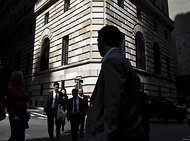PARIS — On a recent Sunday at the sprawling Marché aux Puces de St. Ouen, France’s largest and most famous flea market, crystal chandeliers glinted in a rare patch of Parisian sun.
An ornate Napoleon III-era clock perched on a marble mantelpiece, and sales signs peeked from vintage clothing, vinyl LPs and other curios that have long drawn throngs of shoppers here, jostling for a bargain.
But something seemed amiss on this afternoon, as it has almost every weekend for more than a year. As with so much else now bedeviling France, the economy is to blame. French consumers simply are not spending the way they used to, and that is an impediment not only for the merchants of the Marché aux Puces, but also for the country’s ability to emerge from recession.
“It used to be elbow to elbow here,” said Hamidou Debo, a shoe vendor who sat quietly in his outdoor stall as a handful of people browsed through silver-hued sandals and black leather high-tops before shuffling away without buying. “Now the crowds are around half what they used to be.”
For Mr. Debo and 2,500 other merchants in the 17-acre market on the northern edge of Paris, an economic slowdown has gripped business, and there is no telling when things might turn around. Last year, he said, he regularly made 300 to 400 euros, or $390 to $520, in sales by lunchtime. Now he barely makes 100 euros.
“It’s the crisis,” Mr. Debo said. “People are no longer spending. They are worried about what the future will bring.”
Europe’s long-running economic troubles have been, for the most part, confined to the feeble countries of Europe: Greece, Spain, Portugal and Italy. But more and more they are coming home to roost in France, raising questions about whether one of the Continent’s biggest economies may become the next sick man of Europe.
By many measures, France is already moored in malaise. Unemployment is at its highest point since the current record-keeping system began in 1996 — 10.8 percent — and job creation has been on a downward trajectory for more than a year.
Coupled with tax increases and government spending cuts intended to keep France’s deficit and rising debt under control, the country is now struggling to exit a shallow recession, its second in four years. Even if the recession does end this quarter, the economy is expected to remain stagnant at best, contracting by 0.1 percent this year, according to the French statistics agency Insee.
No wonder French households have tightened their purse strings. But that has become part of the problem, given that consumer spending represents 56 percent of the country’s economic activity.
“The consumer has always been the motor of the French economy,” said Jean-Paul Fitoussi, a professor of economics at the Institut d’Études Politiques de Paris. “If that economic engine does not work, then where is the growth going to come from?”
President François Hollande, who recently acknowledged the economic situation was serious, is offering a grab bag of measures meant to stimulate growth, including a program to create thousands of subsidized jobs for the rising ranks of unemployed youths. This week he announced a plan to invest 12 billion euros in the energy, digital, aerospace and health industries.
Mr. Hollande is also urging the French to be optimistic by citing forecasts that France and the euro zone will begin to emerge from their slump by next year, if all goes well.
But convincing the French may be no easy task.
On Wednesday, the French employers union Medef warned that Mr. Hollande’s policies were destroying 8,000 jobs a day. The chief executives of Peugeot and other French corporations called for “urgent measures” to stem unemployment.
In June, consumer confidence hit its lowest level in France since records started being kept in 1972. With unemployment still rising, households were more pessimistic than ever about the prospects for future living standards, according to Insee. Consumer spending, which contracted last year by 0.4 percent, is expected to remain stagnant for the foreseeable future, despite a slight pickup last month, the agency said.

Article source: http://www.nytimes.com/2013/07/12/business/global/consumer-concerns-weigh-down-french-economy.html?partner=rss&emc=rss

